Meadow maintenance – the balance between wild flowers and grasses
Oh, how times have changed. A generation ago stock farmers, although they understood the medicinal benefits of wildflower meadows in their pasture, would seek ways of controlling “weeds” in order to achieve higher-yielding crops to feed the nation with. Now that farmers have chemical herbicides to help them, we gardeners are worried about the decline in wildflower populations. So much so that we choose to grow them in our own plots. But we’re the opposite of food-producing farmers – we view grass as a weed that spoils our wildflower plots.
So how can we control the ratio of grass to flowers in domestic situations?
Appreciating the beauty and wildlife value of grass
Garden designers like Piet Oudolf deliberately add grasses into their planting plans. The texture, movement and sounds of grasses moving in the wind bring the design to life.
Grasses are also incredibly valuable to wildlife. They provide shelter, places to perch, seeds to eat and for some species, a place to breed and feed their young. Only this morning Maggie dog and I were walking along a grassy field margin. With every step, we were greeted by clouds of Meadow Brown Butterflies who could only exist because of the long grass.
Having long grasses in the garden is a good thing all around – the trick is to incorporate them into the design so that the area doesn’t look unkempt.
Meadowmat is a product that is commonly used to create wildflower areas. It’s quick to install, establishes easily and gives instant groundcover. BUT Meadowmat contains a proportion of wild grasses. Without them, the wildflower blankets would fall apart and be difficult to handle. If you are buying Meadowmat, expect to see grass in it. (they’re beautiful grasses by the way)
Using garden design to turn wild grasses into a wildflower meadow
Simple tricks like mowing paths through your wild meadow area can make a big difference. They make it clear that you have not neglected your garden – rather that you are cultivating a more natural look.
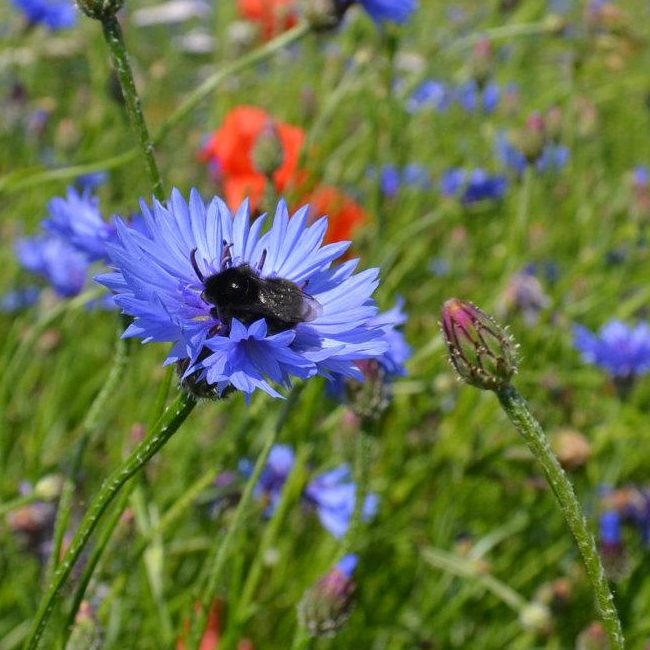
Perhaps you could incorporate a bird feeder, a bug house, a green roof or a wildlife pond to add further interest. A wooden walkway looks very effective and natural with wildflowers, as do ropes strung between posts.
Some Meadowmat customers have admirably chosen to create a wildflower meadow at the front of their houses. For them a sign explaining that this is a conservation area has been very helpful in helping their neighbours to understand what is happening.
If you would like to grow your own little wildflower space then TurfOnline’s Meadowmat Wildflower Turf and seed mat rolls could make that happen for you. Each variety of Meadowmat wildflower meadow turf is a colourful mix of flowering plants and grasses all growing safely and securely onto our proven matting system.
Take a look at our Meadowmat product page descriptions for the perfect mat for you and your garden.
Getting the balance right
As with any aspect of gardening and garden design, it’s all about balance. If the balance between grasses and wildflowers in an ornamental meadow is wrong, the whole thing can look confusing.
For a large meadow area, then it’s OK to have relatively few flowering plants in relation to the grasses. It still looks good. In fact, it creates quite a relaxing space. Ideal for picnics, photography and yoga – maybe even for grazing chickens. This kind of thing often results in a lovely long flowering period that changes from week to week, season to season.
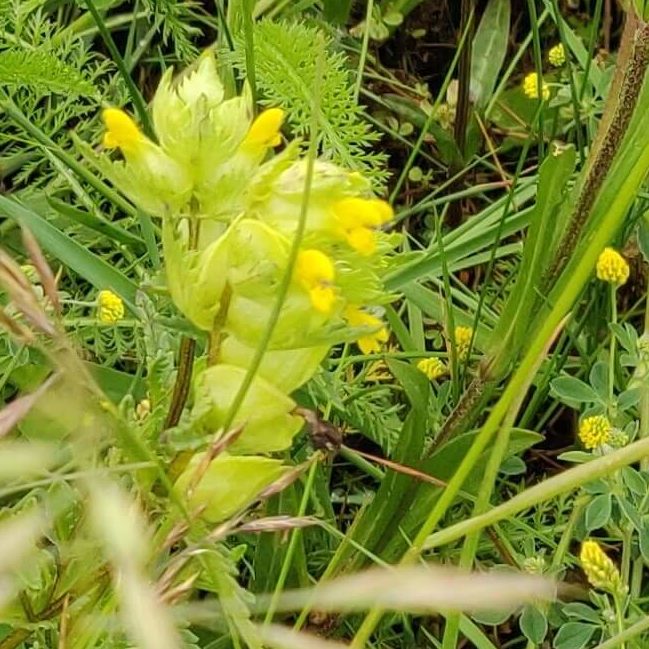
For a small wildflower area, where the emphasis is on visual impact, then you may prefer to have fewer grasses and more flowering plants. Mind you – for that, you may have to sacrifice having a long flowering period. Gardening is always about compromise.
Keeping grasses under control
Meadow management is all about finding that balance between species. It’s about encouraging Mother Nature to see your point of view and getting her to do most of the work.
Soil type
If you have installed Meadowmat or sown wildflower seeds on soil that is rich in nutrients, it’s quite likely that the grasses in the mix will become stronger than the wildflowers. You will need to work harder to manage the grasses on high nutrient soil than you will on low nutrient soil.
Need help choosing a soil? Don’t worry, we can help.
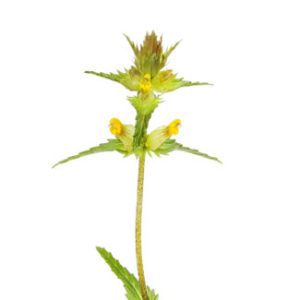 |
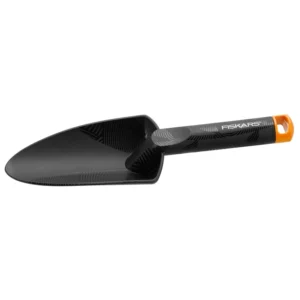 |
|
 |
 |
Using plants to suppress grass
Yellow Rattle aka Hay Rattle always used to be the scourge of the farmer because it suppresses the growth of grasses. If you’re trying to feed sheep, that’s not a good thing. On the other hand, if you are trying to reduce the amount of grass you’re growing, it’s great.
Sow yellow rattle seeds in your wildflower area every autumn. You can buy them online fairly cheaply or you can harvest them from your meadow in summer, save them and sow them a couple of months later. Don’t cover the seed with soil but do make sure they fall onto the bare ground between plants – even if that means uprooting a grass plant or two. Always use fresh seed and always sow in September or October. These are very fussy little plants whose seed needs to feel the frost before it will grow.
Weeding
Yes, Meadowmat IS low maintenance. But as with all things gardening, the amount of work you put in is reflected in the resulting display. To have a wildflower area grow back every year all you need to do is allow Meadowmat to grow and flower and then cut it back once most of the flowers have finished. That’s all, one cut per year and the work is done.
If you want to keep your wildflower area super-floral every year (especially if you are working with higher nutrient soils), you can add in a few extra jobs. These are optional. It’s entirely up to you.
One job is weeding out the grasses by hand. If you feel you have too many grass plants, grab a hand fork and dig some of them out. It doesn’t take long and you can fill the bare patches with plug plants or wildflower seeds.
Planting and over-seeding
Again, these are optional jobs but they can increase the proportion of flowering plants in your wildflower area. Simply clear small areas of the “meadow” and either insert plants or sow seeds of the species you particularly want to see there.
This autumn I shall be adding some foxgloves and cowslips to my mini-meadow by transplanting seedlings that have popped up in other areas of the garden. I have also harvested seeds from the red and white campions and the columbine that grow in my flower borders. I’ll be sowing them amongst the other plants.
Timing your maintenance jobs
Meadows should be cut back once a year and all of the trimmings removed. This helps reduce soil fertility, keep things looking tidy and allow new seeds to germinate.
Traditionally, farmers cut their meadows in June/July. The grasses are still green and full of nutrients so once dried they make excellent animal feed (hay). That does mean though that some of the flowering plants haven’t reached their full potential. They are cut off in their prime. That may not be what is wanted in a garden.
Gardeners tend to wait until everything has finished flowering before they cut their meadows back. The trouble with that is that by then, the grasses will already have dropped their seeds. They look amazing mind you – golden yellow grasses against bright flowers – gorgeous!
By cutting some of the grasses down before they set seed you can influence the amount of grass that grows back next year. You will also disappoint the wildlife that visits your garden precisely for the sanctuary that your mini-meadow provides. Again – it’s down to compromise.
The easiest way to have a low-grass meadow
Planning. By planning the installation of your Meadow area and investing in low nutrient soil you will reduce the risk of grasses spoiling your enjoyment of your meadow area.
Expectations – be open-minded. The plants you first put into your wildflower area may not all thrive. Be prepared to see a different mix of species each year as weather conditions make a big difference to which species dominate.
Maintenance. Keep on top of maintenance. If the plants grow too lush and fall over, trim them back before they can suffocate anything growing beneath them. (Plants that die in this way are often replaced by grass). Add a few new plug plants every year – just for fun.
Feeding. Avoid fertilisers at all costs. So no added compost, no rogue clippings and be careful when feeding nearby plants because fertiliser can leach from one part of the garden to another.
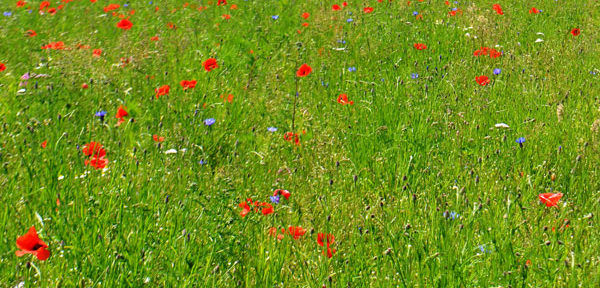
 A wonderful wildflower garden in Essex
A wonderful wildflower garden in Essex  Growing wildflowers on your lawn
Growing wildflowers on your lawn 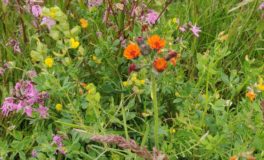 Caring for your new Meadowmat wildflower turf
Caring for your new Meadowmat wildflower turf 

